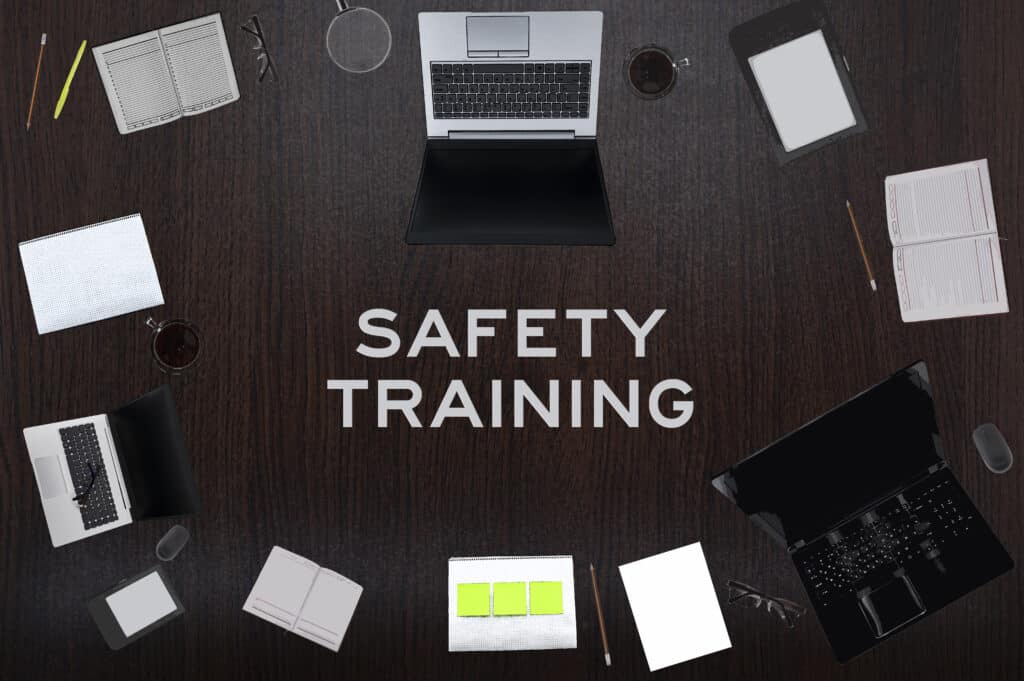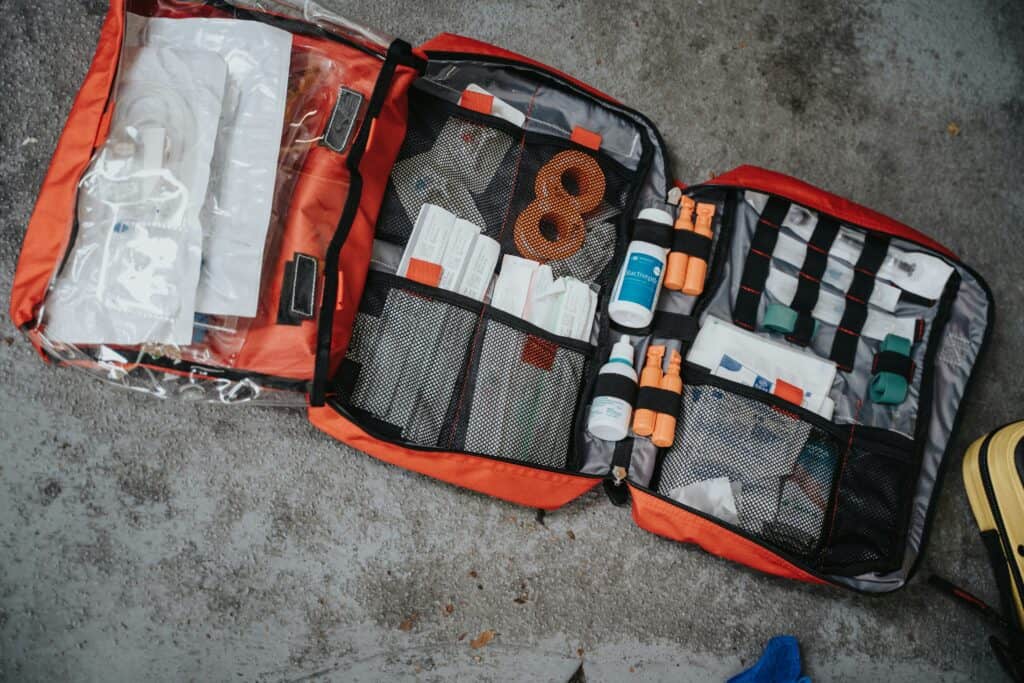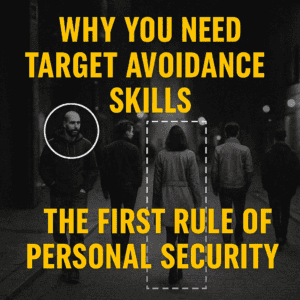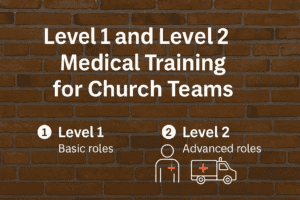Church safety teams play a crucial role in ensuring the security of congregations during worship services and other events.
These teams are often, but not always, comprised of volunteers with backgrounds in law enforcement, military service, or security, as well as medical professionals such as doctors, nurses, and EMTs.
The primary responsibility of a church safety team is to protect the congregation from potential threats, respond to emergency situations, and create a secure environment for worship.
Regular training is essential for church safety teams to effectively carry out their mission and adapt to evolving threats and challenges.
Ongoing training sessions focus on various safety and security scenarios, including firearm competency, shoot/don’t shoot situations, rules of engagement, and de-escalation practices.
These skills not only help prepare team members for handling threats but also foster a sense of awareness and understanding among the congregation about the importance of church security.
By investing in continuous learning and development, church safety teams can ensure they are well-equipped to tackle any situation that may arise and provide a secure, welcoming environment for their community.
The Role of Church Safety Teams
Church Safety Teams play a crucial role in maintaining the security and well-being of the congregation and the church property.
These teams are responsible for various tasks, ranging from protecting the congregation during services to ensuring the church premises are safe for all visitors.
In this section, we will discuss the key roles and responsibilities of a Church Safety Team.
Church Safety Teams are primarily responsible for the overall safety of the church members and the church facility.
This responsibility includes developing and implementing safety procedures, managing potential threats, and addressing any security concerns that may arise.
Examples of safety-related tasks include monitoring doorways during services, inspecting the premises for potential hazards, and conducting fire drills, to name a few.
Team members should actively participate in regular training sessions to reinforce their expertise in various safety and security scenarios.
As mentioned above, this training can cover topics such as firearm competency, shoot/don’t shoot scenarios, rules of engagement, de-escalation practices, and tabletop exercises.
Continuous learning is essential for maximizing the effectiveness of a church security team and better preparing them for evolving threats and challenges.
A well-organized Church Safety Team requires strong leadership to effectively coordinate the team’s efforts and ensure they follow the established protocols.
Leaders are responsible for selecting team members based on their skills and experience and ensuring they receive the necessary training.
They also oversee the scheduling and assignment of team members for various duties, such as patrolling the grounds during events, supervising access control points, and monitoring security systems.
Coordination is another essential aspect of a Church Safety Team.
Efficient communication between team members and other church staff helps maintain a safe environment for all members of the congregation.
For example, team members can inform the church staff of potential security concerns, enabling appropriate action to be taken to mitigate any risks or disturbances.
Church Safety Teams play a vital role in ensuring the safety and security of the people and property in a church community.
Their essential duties include maintaining security during services, developing safety procedures, and responding to potential threats.
With proper leadership, coordination, and regular training sessions, these teams can fulfill their roles effectively and provide a safe and secure environment for congregations.
Importance of Regular Training
By continuously updating their knowledge base and reinforcing their skills, team members remain prepared to tackle various safety and security scenarios that might arise in a church setting.
Ongoing training ensures that safety team members are able to competently handle situations requiring quick decision-making and action.
To provide a comprehensive safety program, it is essential to cover various aspects of church security.
Regular training sessions ensure that safety team members are thoroughly experienced and ready to respond in the event of an emergency.
Proactive training tactics like role-playing and simulations also enhance the team’s capabilities, encouraging quick thinking and the ability to adapt to different scenarios.
These exercises additionally foster teamwork and communication, which are invaluable skills for a successful safety team.
Maintaining training records is also important when building a professional and competent safety team.
Records ensure that all team members are up-to-date with their training and that any gaps in knowledge are addressed.
Moreover, having a systematic record of team members’ training progression builds trust among the congregation, as it shows the church’s commitment to their safety.
The importance of regular training for a church safety team cannot be overstated.
A well-trained team ensures the safety of church members, fosters trust and support in the community, and provides a welcoming environment for everyone attending.
Building the Safety and Security Procedures
Creating effective safety and security procedures for a church safety team involves a combination of policies, guidelines, and ongoing training.
A solid foundation of well-defined procedures not only helps the safety team to function efficiently but also promotes a secure environment for church members and visitors.
One of the first steps in building these procedures is to establish clear policies and procedures that outline the roles and responsibilities of the safety team.
This includes setting goals for the team, such as ensuring the safety and security of all church members, staff, and visitors.
These should emphasize the importance of maintaining a welcoming environment while prioritizing the well-being of the congregation.
Next, consider creating guidelines for the safety team to follow, such as communication protocols or selecting appropriate equipment.
Another crucial aspect of building safety and security procedures is ensuring that the safety team members receive regular training.
Emphasize the importance of drills for various emergency scenarios to reinforce the team’s skills and preparedness.
To supplement the training, consider establishing a reporting system for team members to log incidents, concerns, or observations.
Regularly reviewing this data helps the team to identify patterns, address vulnerabilities, and make informed decisions about future safety improvements.
Finally, commit to fostering a culture of teamwork among the safety team members.
Encourage open communication, collaboration, and peer support to help the team function more effectively and efficiently.
By working together, the safety team can better anticipate potential issues, respond to emergencies, and ensure the security of the church community.
Building a comprehensive set of safety and security procedures for a church safety team involves establishing clear policies and guidelines, providing ongoing training and support, fostering a culture of teamwork, and continuously evaluating and improving the team’s efforts.
Collaboration with Law Enforcement
Collaborating with local law enforcement is a crucial aspect of church safety team operations.
Establishing a strong relationship with law enforcement officials can significantly increase the effectiveness of security measures and help in addressing potential threats.
Open communication with law enforcement officials also keeps the church safety team up-to-date with any changes in protocols and regulations.
Another benefit of close collaboration with local law enforcement is the opportunity to participate in joint training sessions.
These sessions can help church safety teams gain valuable hands-on experience and ensure that they are prepared for real-life emergencies.
For example, law enforcement may offer active shooter response training specifically tailored to the unique challenges faced by places of worship.
Additionally, coordination between church safety teams and law enforcement can streamline emergency response efforts.
If an incident were to occur, a church safety team that maintains a relationship with law enforcement would be able to quickly provide essential information to responding officers, potentially saving crucial time and lives.
Fostering collaboration with law enforcement is an essential component of church safety team operations.
This relationship not only enhances the effectiveness of security measures but also ensures that the safety team remains at the forefront of best practices in the evolving world of church security.
Medical Emergency Preparedness
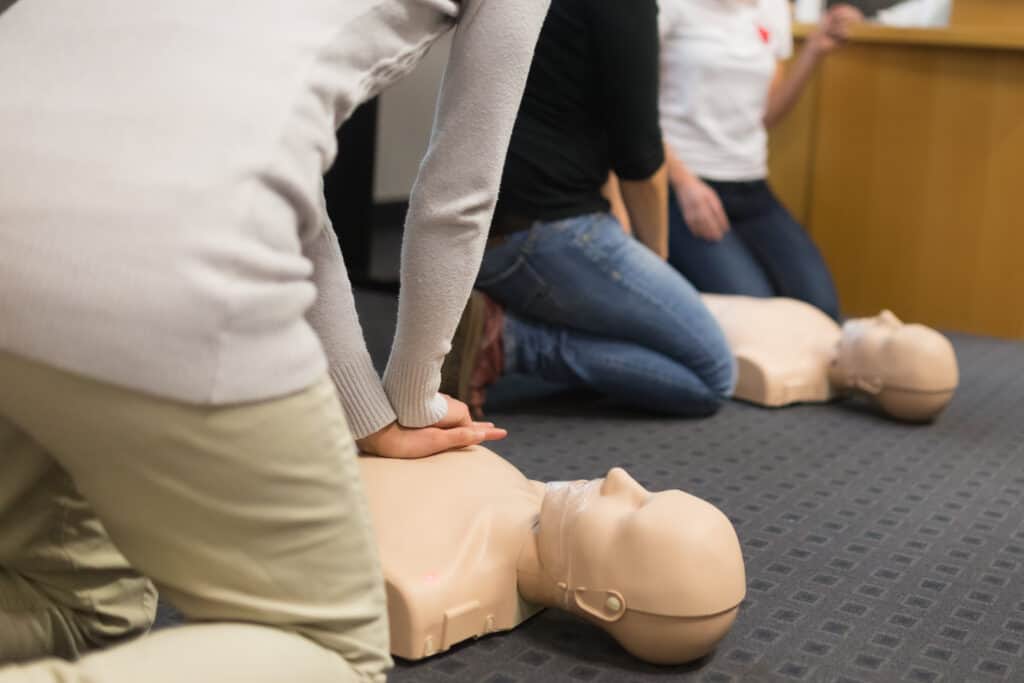
Being prepared for medical emergencies is a vital aspect of a Church Safety Team’s responsibilities.
Establishing and maintaining a well-trained medical response team can make the difference between life and death when an emergency occurs.
To effectively respond to medical emergencies, team members must become proficient in emergency response procedures.
This includes things like knowing how to assess a situation, administer first aid, and utilize Automated External Defibrillators (AEDs) when necessary.
Church Safety Teams must also maintain an adequate supply of first aid equipment.
This includes items such as bandages, gauze, disinfectants, and AEDs, among others.
Proper storage and regular checks on these supplies are crucial, as expired or damaged items can become ineffective in an emergency situation.
In addition to training in essential medical skills, Church Safety Teams should be knowledgeable about their facility’s emergency response plan.
This involves:
- Knowing the location of emergency exits
- Identifying designated meeting points in case of evacuation
- Familiarity with the building’s layout to help guide emergency personnel
Ensuring that team members are well-versed in emergency response procedures can significantly improve the effectiveness of a Church Safety Team in a crisis.
Collaboration between the Church Safety Team and local emergency personnel is yet another key aspect of medical emergency preparedness.
Regular communication and coordination with paramedics, firefighters, and the local police force helps to:
- Foster relationships with key community partners
- Ensure a more effective and efficient response in case of an emergency
- Share resources and knowledge to improve overall safety and preparedness
By prioritizing and conducting regular training in emergency response, first aid, and AED use, Church Safety Teams can be better prepared to handle medical emergencies and provide a safer environment for their congregation.
Addressing Various Threats and Risks
One vital aspect of church safety team training is focusing on situational awareness and threat detection.
This helps team members identify potential threats, suspicious behaviors, and unusual activities within the church premises.
As many threats can be unpredictable and vary in nature, a well-rounded approach to training allows the team to adapt and respond to different situations.
Beyond physical threats, it’s essential to also prepare for various potential risks that may not be immediately apparent.
Church safety teams collaborating closely with local law enforcement agencies can stay informed about emerging trends and best practices in church safety and security.
By partnering with experts in the field, teams can proactively address evolving threats and keep their congregations safe.
A critical aspect of addressing various threats and risks is developing a comprehensive emergency preparedness plan.
This involves identifying the church’s overall preparedness level, and ensuring that the safety team is prepared for any type of emergency.
Regularly rehearsing the plan, both mentally and physically, can reduce response time and build confidence in the team’s ability to handle emergencies effectively.
Handling Evacuations
Evacuations are a crucial aspect of church safety team training.
A well-prepared safety team should be able to carry out evacuation procedures efficiently and orderly should an emergency arise.
It is essential for church safety teams to undergo regular training sessions to effectively coordinate evacuations, ensure congregation members are familiar with exit points, and maintain a calm atmosphere during crises.
Developing Evacuation Procedures is a vital step in safeguarding the congregation.
These procedures should include details such as designated exit points, personnel roles during evacuation, guidelines for assisting vulnerable members, and plans for communication and reunification after evacuations.
Safety team members should be proficient in these procedures to direct the congregation and ensure a smooth and orderly evacuation.
Church safety teams must also consider the unique layout and structure of their buildings when planning evacuations.
This may involve elements such as:
- Identifying multiple exit points
- Ensuring proper signage in hallways and exit doors
- Maintaining clear and unobstructed evacuation paths
Training sessions should include scenario-based drills to simulate real-life situations, allowing the safety team to evaluate and refine their evacuation protocols.
These drills will enable team members to work cohesively in directing the congregation during emergencies and dealing with potential obstacles or challenges.
Communication plays a critical role in successful evacuations.
The safety team should establish a reliable communication system to update and inform team members of unfolding situations.
Additionally, team members must communicate effectively with the congregation to provide clear instructions and updates during evacuation procedures.
In-Person Practical Training Drills
In-person practical training exercises play a crucial role in maintaining the effectiveness of a church safety team.
These exercises can include both physical and mental training, such as drills, tabletop exercises, and scenario-based simulations.
Regularly conducting in-person practical training exercises ensures the team is prepared, confident, and adaptive to various security situations.
These can be designed to test the team’s response to potential emergencies, such as evacuating the church during a fire or managing an active shooter situation.
Drills help improve the team’s coordination, decision-making skills, and adaptability under high-stress situations.
Participation in training and drills for church security promotes a culture of vigilance and preparedness.
Tabletop exercises are another crucial component of on-field training.
In these exercises, team members gather around a table to discuss and analyze hypothetical security scenarios.
They can cover a wide range of topics, from natural disasters to medical emergencies, helping the team to anticipate and prepare for various security situations.
Tabletop exercises are also useful for reinforcing safety and security policies and procedures, as well as building teamwork and communication skills.
Scenario-based simulations are also valuable tools for church safety team training.
In these exercises, team members are exposed to realistic situations that require them to make swift, effective decisions.
These simulations enable the team to hone their skills and build expertise in handling a diverse set of safety and security challenges.
De-Escalation Techniques and Their Application

De-escalation techniques are crucial for church safety teams as they can prevent a potentially violent situation from getting worse.
These techniques can be broadly divided into two categories: verbal and non-verbal techniques.
Verbal de-escalation techniques
Verbal de-escalation techniques focus on the use of communication skills to calm down a tense situation. These include:
- Active listening: Show empathy and understanding by truly listening to the individual’s concerns or grievances.
- Using a calm voice: Speak slowly, clearly, and at a consistent volume to convey a sense of control and assurance.
- Avoiding confrontation: Refrain from entering into a debate or escalating the conflict by using closed-ended questions.
The Bible emphasizes the importance of using words wisely as it states, “the tongue holds the power of life and death” (Proverbs 18:21).
Non-verbal de-escalation techniques
Non-verbal de-escalation techniques involve body language, facial expressions, and gestures that can help communicate a sense of calm and reassurance to the individual. Some non-verbal techniques are:
- Maintaining a safe distance: Give the person enough space to feel comfortable and ensure that they do not feel cornered.
- Using open body language: Make sure that your gestures and posture convey a non-threatening presence.
- Offering alternatives: Provide options to resolve the situation peacefully, such as the option to discuss their concerns privately.
Regular training is essential for church safety team members to effectively implement these de-escalation techniques.
Safety team members can benefit from mock drills and tabletop exercises that help them practice these techniques in realistic scenarios.
Mitigating Liability and Insurance Concerns
A well-trained church safety team plays a vital role in mitigating liability and insurance concerns.
Regular training not only helps to prevent accidents and incidents but also demonstrates to insurance providers that the church is committed to maintaining a safe environment for all congregants.
Churches often face a range of liability issues including injury claims and property damage.
Having a church safety team that is well-versed in protocols and procedures can help reduce the likelihood of such incidents.
I will reiterate, options to consider for appropriate training topics can include firearm competency, shoot/don’t shoot scenarios, rules of engagement, and de-escalation practices, which are all crucial components in minimizing liability risks.
This, in turn, may also lead to lower insurance premiums, as insurers sometimes reward organizations that prioritize safety and security with more favorable rates.
Ongoing training and well-executed emergency drills are key to maintaining preparedness and reducing liability exposure.
Moreover, comprehensive background checks for all team members are essential in mitigating liabilities and reassuring insurance providers.
By ensuring that safety team members have passed rigorous background checks, churches demonstrate their commitment to the safety and well-being of their congregants.
Maintaining Church Security in a Digital Age
In the modern era, ensuring the safety of church-goers goes beyond physical protection.
Cybersecurity has now become a focal point in developing a comprehensive church security strategy.
This is essential as the use of technology and online platforms within religious institutions continues to grow.
Churches are increasingly relying on digital tools for communication, financial transactions, and storage of sensitive information.
These activities make them a potential target for cyberattacks.
To safeguard against potential threats, it is crucial to implement robust cybersecurity measures and stay up-to-date with the latest security techniques.
One way to strengthen protection against cyber threats is through regular software updates.
Church administrators should ensure they are using up-to-date antivirus and anti-malware programs, and timely installing any security patches or updates for their operating systems and software applications.
Additionally, it is essential to educate church staff and volunteers about cybersecurity best practices.
This may include training on how to recognize and avoid phishing attacks, creating strong passwords, and securing personal devices used for church-related work.
Having a well-informed team can significantly reduce the risk of falling victim to cybercriminals.
Finally, churches should consider adopting multi-factor authentication (MFA) for accessing sensitive information and systems.
MFA requires individuals to provide two or more forms of identification before being granted access, making it more challenging for unauthorized users to breach the system.
By taking these crucial steps, you can ensure your church remains a secure and welcoming haven for your congregation in both the physical and the digital realms.
Adapting to Evolving Security Needs
Church safety teams play a vital role in protecting congregations and ensuring the well-being of their members.
One of the key components of an effective safety team is the ability to adapt and evolve in response to the changing needs of churches and their communities.
Adaptations to security procedures and protocols can often be prompted by assessments conducted by experienced entities like Risk Strategy Group.
These assessments help identify areas where improvements can be made, as well as define realistic goals for the safety team.
Another vital factor in adapting to evolving security needs is fostering a culture of vigilance and preparation within the congregation.
By involving members in discussions about safety and security, churches can help raise awareness of potential threats and encourage a proactive approach to risk management.
Effective adaptation to evolving security needs also requires maintaining a high level of situational awareness.
This involves monitoring local and global security trends, regularly reviewing incident reports, and ensuring that team members are kept informed of any new developments or threats.
Situational awareness enables church safety teams to respond quickly and efficiently to emerging security challenges, thereby increasing their overall effectiveness.
Safety Measures during Special Occasions
Special occasions, such as the Christmas season, often bring an influx of visitors to churches.
It becomes increasingly important to have well-trained Church Safety Teams in place to ensure the security and well-being of both the congregation and the facilities.
One of the fundamental aspects of a safety team’s training is mastering emergency response protocols.
These protocols include, but are not limited to, evacuation procedures, sheltering, lockdown protocols, and first aid drills.
Knowledge in these areas allows the team to respond swiftly and efficiently in case of emergencies or threats.
During special occasions, the church safety team must be mindful of any potential risks associated with higher attendance.
For instance, they should monitor and manage crowd behavior, maintain situational awareness, and keep emergency exits accessible.
Additionally, the team should be proficient in identifying any signs of potential threats or disturbances, such as suspicious behavior or physical distress.
An effective church safety team should also be knowledgeable in managing common safety concerns during special events, such as:
- Fire safety: Ensuring fire extinguishers are available, operational, and in their correct locations. Conducting and communicating fire drills to the congregation.
- Medical emergencies: Providing prompt assistance in case of health issues, and ensuring the presence of medical supplies, such as first aid kits and automated external defibrillators (AED).
- Child safety: Implementing and monitoring child protection measures, such as check-in/check-out systems, background checks for volunteers and staff, and age-appropriate supervision.
It is essential to strike a balance between safety concerns and the need for a welcoming atmosphere.
To achieve this balance, a safety team must be able to engage with attendees in a friendly and professional manner.
This approach eliminates any unnecessary tension and ensures a positive experience for both the church members and visitors alike.
Conclusion
Regular training plays a crucial role in maintaining the effectiveness of church security teams and safety teams.
A well-trained team can respond appropriately to various threats and incidents, ensuring the safety of congregants and preserving religious freedom.
By staying up to date with best practices, teams can successfully fulfill their shepherding ministries and safeguard individuals in their care.
Training should cover topics such as firearm competency, shoot/don’t shoot scenarios, rules of engagement, de-escalation practices, and tabletop exercises.
Fire safety plans and school safety plans can also be integrated into the training curriculum to prepare teams for all types of emergencies.
Volunteer safety is another crucial aspect to consider.
Providing training for all volunteers involved in safety and security measures ensures they are equipped with the necessary knowledge and skills to handle potential incidents.
This instills confidence in the team and fosters trust among the congregation.
It’s important to strike a balance between maintaining a welcoming atmosphere for worship while also ensuring safety and security.
Regular training for church security teams helps them actively protect their communities without compromising the sanctity of the worship environment.
Frequently Asked Questions
What are the key components of an effective church safety team?
An effective church safety team typically includes volunteers with diverse backgrounds, such as law enforcement, military service, and security. The team should also have a separate medical team, comprising individuals with expertise in medicine, nursing, and emergency medical services. Establishing a strong team structure, with clear leadership and coordination, helps ensure the safety and protection of the congregation during worship services and events. Learn more here
How can regular training enhance a church safety team’s response to emergencies?
Regular training allows church safety team members to constantly improve their skills, adapt to evolving threats, and respond to emergencies more effectively. Through ongoing training, security personnel can develop and maintain a high level of competency in various safety and security scenarios.
What types of scenarios should a church safety team be prepared to handle?
A church safety team should be trained to handle a wide range of scenarios, including potential firearm incidents, physical altercations, medical emergencies, and situations requiring de-escalation techniques. By performing tabletop exercises and practicing various response techniques, team members can become proficient in dealing with diverse safety and security situations. Learn more about the scenarios a church safety team should be prepared for
How does ongoing training keep a church safety team up-to-date on security best practices and policies?
Ongoing training ensures that church safety team members stay informed about the latest safety and security best practices, techniques, and policies. By participating in regular training sessions, they can learn about emerging threats, new technologies, and updated protocols. This continuous learning process helps the team maintain the highest level of preparedness and adapt to ever-changing security conditions.
What role does communication play in ensuring the success of a well-trained church safety team?
Effective communication is crucial in maintaining the success of a well-trained church safety team. Team members must be able to communicate clearly and efficiently with each other during emergencies, as well as with congregants and local emergency responders. Good communication skills also help build trust and rapport with the congregation, fostering a sense of safety and reassurance.
How can a church safety team measure the effectiveness of their training?
To evaluate the effectiveness of their training, church safety teams can employ various methods, such as conducting practical exercises, assessing the team’s response to simulated emergency situations, and requesting feedback from team members and congregants. By regularly reviewing and analyzing their performance, church safety teams can identify areas for improvement and refine their training protocols accordingly.

